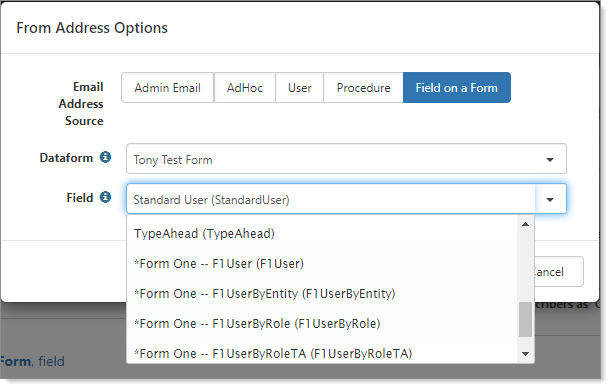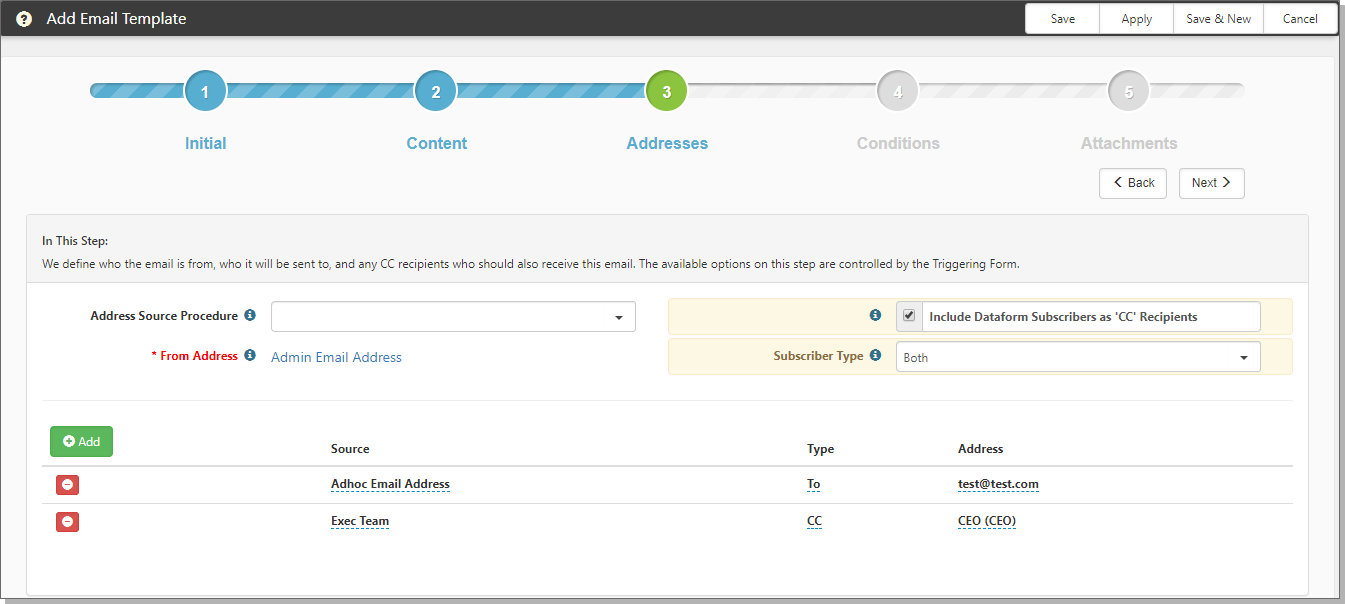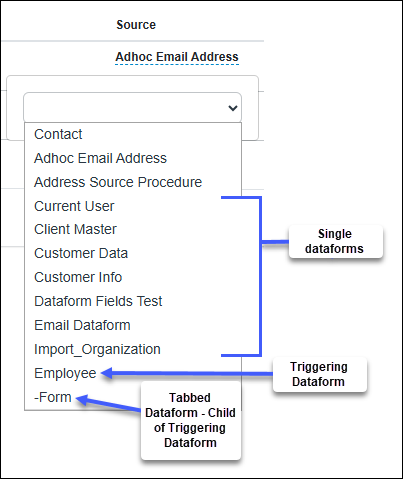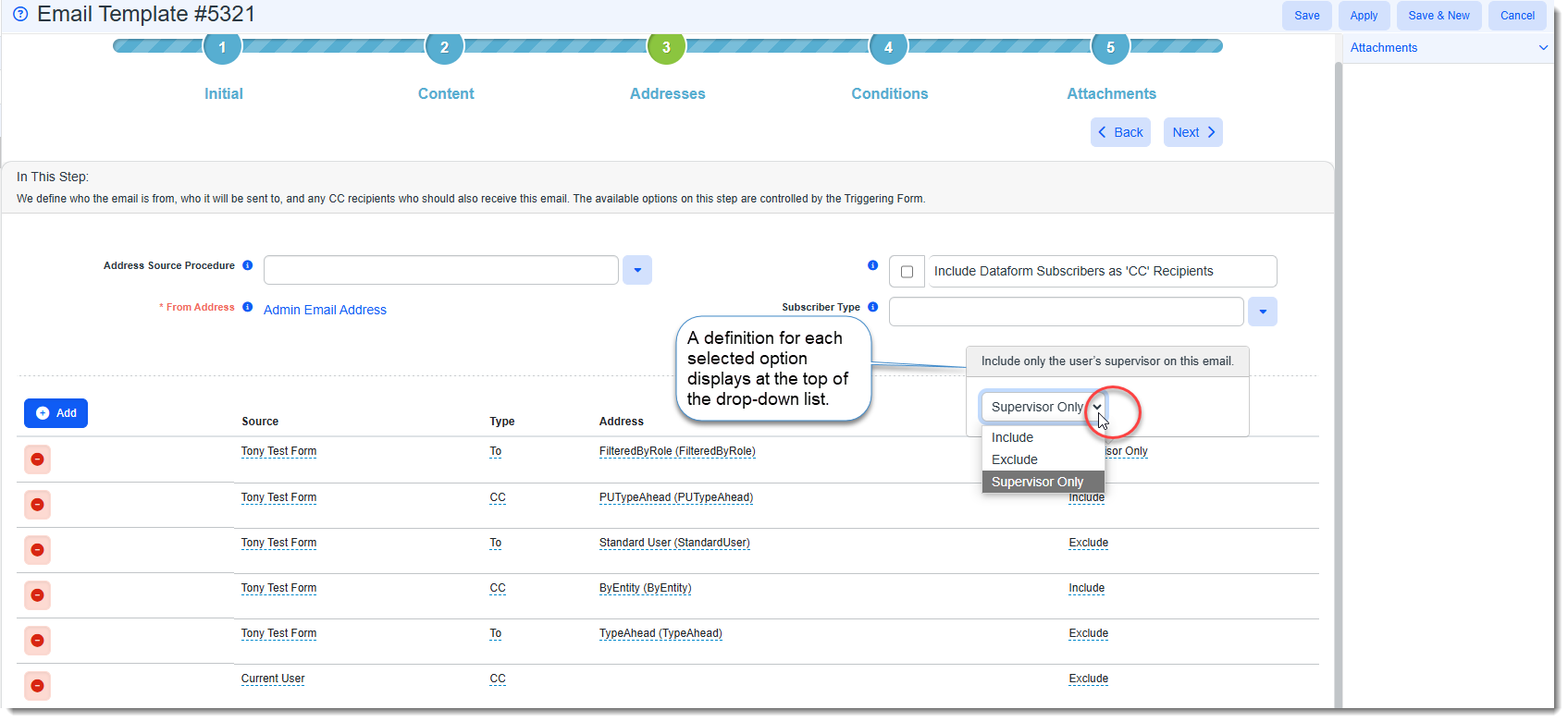This step defines who the email is from, who will receive it, and any CC recipients. You can use a custom stored procedure to include email addresses from system objects other than the triggering form. By default, the system excludes the current user who triggers the email. In Source, you can select Current User to ensure that user receives an email.
Note: There are two administrative settings below are used to set an Email Template recipient limit. To inquire about changes to these settings, log an extranet case.
-
Max Recipient Count - Sets a default threshold of 200 on the number of email recipients for both "To" and "CC" email recipients.
-
Max Recipient Role Send To - The field value in this field defaults to Global Administrator and cannot be edited. This allows members of the Global Administrators role to receive a system email stating the following when the Max Recipient Count threshold is exceeded: "The recipient list is too great for [EmailTemplateName] to be sent. More details can be found in the Exception Log."
To configure recipients:
| 1. | Complete the form fields. |
| Address Source Procedure | Select a stored procedure (optional) that generates data to provide additional recipient email addresses. Select from any stored procedure in the system with a name containing emailtemplate_recipient_proc. The recipient proc list only displays valid options based on the Triggering Form in Step 1. | |||||||||
|
Include Dataform Subscribers as CC Recipients |
Adds anyone who has subscribed to the dataform as CC recipients when this notification is sent in addition to any other recipients you configure here. When enabled (selected), this option presents a list to notify internal, external, or both recipient types:
Note: If you select this option, use the {RecipientsCC} replacement field in the Body of the message on Step 2: Content when you want to include the email address of the CC recipient(s) in the email message. See Step 2: Content. |
|||||||||
|
From Address |
Select the From Address for the email. You can set this field to the email of the default admin user, a specific user, or from a field on a form.
This field defaults to Admin Email Address, which is the application administrator's email address. This is the default admin email set in System Admin > Advanced > App Settings. Only User Developers can change this email address.
To select from a distinct set of options:
|
| 2. | To add a new recipient record to this notification, click Add. |
A new row opens for Source, Type, and Address. Each recipient's source, type, and address must be unique.
| 3. | Complete the fields: |
|
Source |
Source is where you select the source of your recipient email addresses or user contacts. When you select a source from the list, then any available email addresses or user contacts are available in the Address column. Recipient Source options are: |
|||||||||
|
|
||||||||||
| Type |
What kind of email recipient type are you setting? Options are To or CC. Note: Use the {RecipientsTO} and {RecipientsCC} replacement fields in the Body of the message on Step 2: Content when you want to include the email addresses of the TO and CC recipients in the email message. See Step 2: Content. |
|||||||||
|
Address |
Note: Recipient type options may vary depending on the selected Address Source Procedure.
|
|||||||||
|
Supervisor |
The Supervisor column is enabled when you select any internal user field (such as User, Role, Project User, etc.) as a recipient in the Address column with either a dataform or "Current User" as Source. Once enabled, when you click in the Supervisor column on a line item in the grid, a drop-down menu displays: You can select one of the following options from the drop-down list of the Supervisor column:
Note: If you select Include and no supervisor is associated with the user or there is no valid email address, the email will only be sent to the recipient identified in the Address column. If you select Supervisor Only and no supervisor is associated with the user or there is no valid email address, the email will not be sent for the affected recipient record. |
| 4. | Click Next to proceed to Step 4: Conditions. |
From a Field on a Form
From the From Address Options dialog box, when you select From a Field on a Form, you can set user fields to values that exist on dataforms across a tabbed set. You can choose from which Dataform and then when you select a dataform, choose the Field. The Dataform drives the items in the Field list that you choose. The user fields include any child forms in a tabbed relationship. The child form has an asterisk in the name, as in *Form One -- F1 User(F1User).




 The triggering dataform selected in Step 1 Initial. In the example, the Triggering Form is Employee.
The triggering dataform selected in Step 1 Initial. In the example, the Triggering Form is Employee.